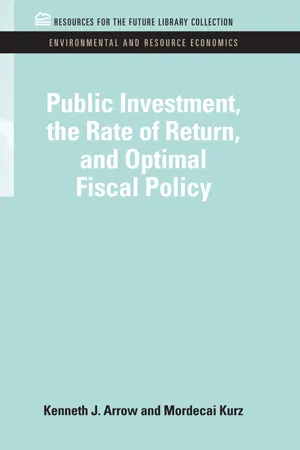
eBook - ePub
Public Investment, the Rate of Return, and Optimal Fiscal Policy
This is a test
- 218 pages
- English
- ePUB (mobile friendly)
- Available on iOS & Android
eBook - ePub
Public Investment, the Rate of Return, and Optimal Fiscal Policy
Book details
Book preview
Table of contents
Citations
About This Book
This book, co-authored by the Nobel-prized economist, Kenneth Arrow, considers public expenditures in the context of modern growth theory. It analyzes optimal growth with public capital. A theory of 'controllability' is developed and injected into public economics and growth models.Originally published in 1970
Frequently asked questions
At the moment all of our mobile-responsive ePub books are available to download via the app. Most of our PDFs are also available to download and we're working on making the final remaining ones downloadable now. Learn more here.
Both plans give you full access to the library and all of Perlego’s features. The only differences are the price and subscription period: With the annual plan you’ll save around 30% compared to 12 months on the monthly plan.
We are an online textbook subscription service, where you can get access to an entire online library for less than the price of a single book per month. With over 1 million books across 1000+ topics, we’ve got you covered! Learn more here.
Look out for the read-aloud symbol on your next book to see if you can listen to it. The read-aloud tool reads text aloud for you, highlighting the text as it is being read. You can pause it, speed it up and slow it down. Learn more here.
Yes, you can access Public Investment, the Rate of Return, and Optimal Fiscal Policy by Kenneth J. Arrow, Mordecai Kruz in PDF and/or ePUB format, as well as other popular books in Business & Financial Accounting. We have over one million books available in our catalogue for you to explore.
II
Methods of Optimization over Time
0. Introduction
This chapter is designed as a heuristic introduction to modern methods of optimization over time. Investment planning, whether public or private, is, of course, a most important example of intertemporal optimization.
The exposition to be given here follows the modern techniques developed in the last twenty years—especially by the American mathematician, Richard Bellman (1957), and the Russian mathematician, L. S. Pontryagin (1962)—though they are a natural development of the calculus of variations studied since the seventeenth century and already used in an economic context by such writers as Frank P. Ramsey (1928), Harold Hotelling (1931), G. C. Evans (1930, chapters 14 and 15, and appendix 2), and Pierre Massé (1946).
It is not possible to give a rigorous derivation of the mathematical methods to be employed. Our intention here is simply to be suggestive and heuristic. The techniques to be used are especially those of Pontryagin and his associates, but they will be motivated from the viewpoint of Bellman's methods of "dynamic programming."
1. Dynamic Programming: Discrete Time, Finite Horizon
We imagine a system, economic or other, evolving in time. For the present assume that time is discrete; that is, it is divided into periods (days, months, years). At any moment of time, the system is in some state, which can be described by a finite number of coordinates. For an economic system, the amount of capital goods of each type might constitute a suitable state description. Let the values of the state variables at time t be denoted by x1(t)...,x8(t).
In an optimization problem, there is some possibility of controlling the system. Thus, at any time t, there are some variables v1(t),..., vn(t), which can be chosen by a decision maker. The variables Vi(t) are frequently referred to in the literature as control or decision variables; following the terminology of Tinbergen (1952, p. 7) in a static context, we here use the term instruments. In an economic system, the instruments are typically the allocations of resources to different productive uses and to consumption, or perhaps taxes and bond issues which at least partially determine allocations.
It is assumed that the state and the instrument variables at any point of time completely determine the state of the system at the next point of time. Thus, for a given technology and labor force, the outputs of all goods are determined by the capital structure (state variables) together with its allocation among different uses (by some of the instruments). The goods, in turn, are allocated between consumption and capital ...
Table of contents
- Cover
- Title
- Copyright
- Original Title
- Original Copyright
- FOREWORD
- Contents
- ACKNOWLEDGMENTS
- THE FORMAT OF THE BOOK
- SUMMARY
- I. BASIC CONCEPTS FOR THE THEORY OF PUBLIC INVESTMENT
- II. METHODS OF OPTIMIZATION OVER TIME
- III. OPTIMAL INVESTMENT PLANNING IN A ONE-COMMODITY MODEL
- IV. OPTIMAL INVESTMENTS IN A TWO-SECTOR MODEL
- V. OBJECTIVES, MARKETS, AND PUBLIC INSTRUMENTS
- VI. OPTIMAL POLICY AND CONTROLLABILITY WITH IMPERFECT CAPITAL MARKETS
- VII. CONSUMER BEHAVIOR IN A PERFECT MARKET
- VIII. CONTROLLABILITY OF PUBLIC POLICY IN PERFECT CAPITAL MARKETS
- Bibliography
- Index